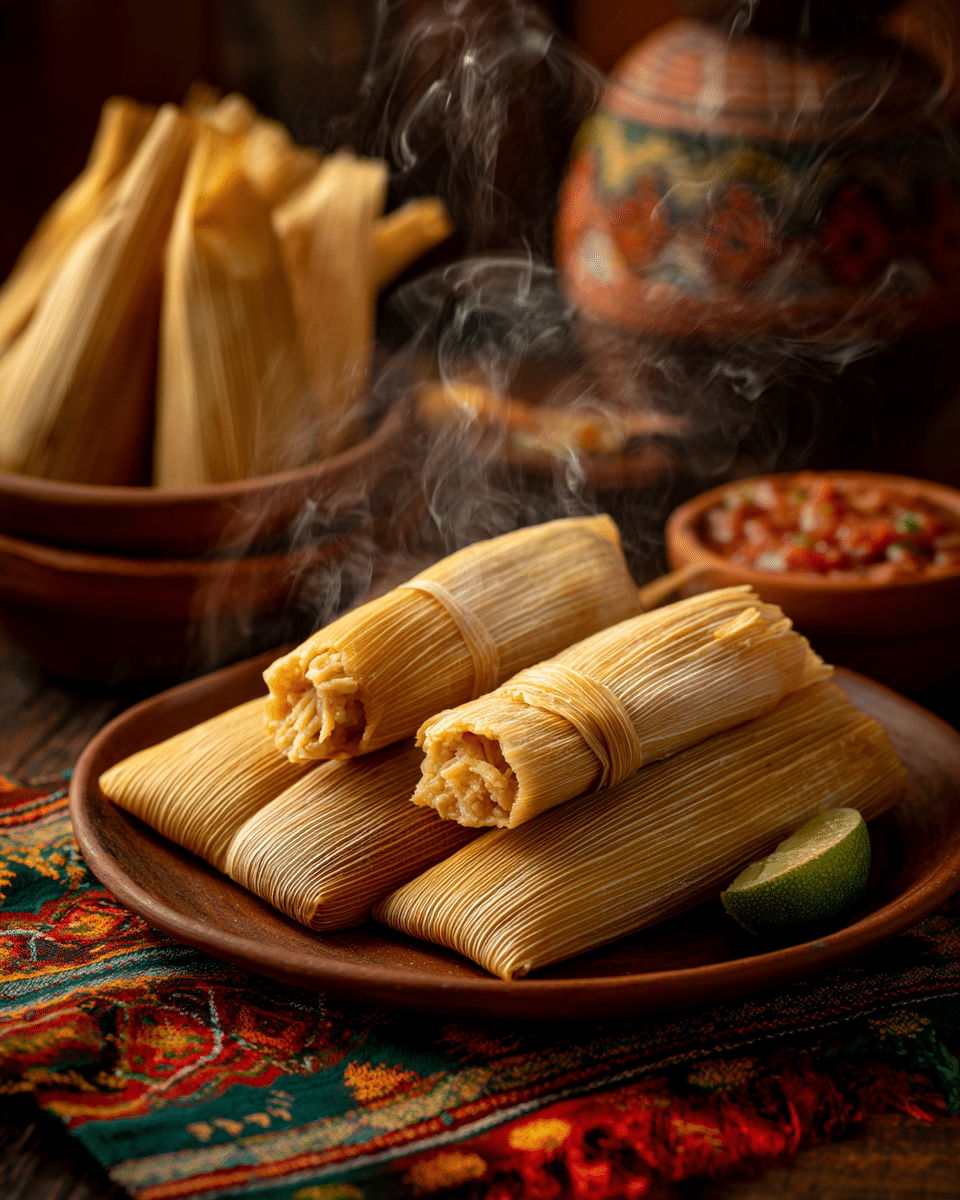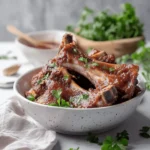Tamales are a beloved traditional dish in many Latin American cultures, particularly in Mexico and Central America. Made with a flavorful corn masa dough, they are typically filled with a savory or sweet filling, then wrapped in corn husks and steamed to perfection. Tamales are commonly prepared for special occasions and holidays, and their preparation often brings families together for a communal cooking experience.
FULL RECIPE
Ingredients
1.For the Masa (Dough):
- 4 cups masa harina (corn flour for tamales)
- 2 ½ cups warm chicken broth
- 1 ½ teaspoons baking powder
- 1 teaspoon salt
- 1 cup lard or vegetable shortening
2.For the Filling:
- 2 lbs pork shoulder or chicken, cooked and shredded
- 2 tablespoons vegetable oil
- 4 dried guajillo chiles, stemmed and seeded
- 2 dried ancho chiles, stemmed and seeded
- 3 cloves garlic
- 1 teaspoon ground cumin
- ½ teaspoon dried oregano
- 1 teaspoon salt
- 1 ½ cups chicken broth
3.For Assembly:
- 30 dried corn husks, soaked in warm water for 30 minutes
Directions
- Prepare the Filling:
In a skillet over medium heat, toast the guajillo and ancho chiles for about 1–2 minutes until fragrant. Transfer to a bowl and soak in hot water for 15 minutes to soften. - Make Chile Sauce:
Drain the soaked chiles and add them to a blender with garlic, cumin, oregano, salt, and 1½ cups of chicken broth. Blend until smooth. Heat 2 tablespoons oil in a skillet, pour in the sauce, and cook for 5 minutes. Add shredded meat and simmer for 10 minutes. Set aside to cool. - Make the Masa:
In a large bowl, mix masa harina, baking powder, and salt. Add warm chicken broth gradually, stirring to combine. In a separate bowl, beat the lard until fluffy, then mix it into the masa dough. Knead until the dough is smooth and easily spreadable. - Assemble the Tamales:
Lay a soaked corn husk flat, smooth side up. Spread 2 tablespoons of masa onto the center, forming a rectangle. Add 1 tablespoon of the meat filling on top. Fold the sides inward, then fold the bottom up to enclose. Repeat with remaining ingredients. - Steam the Tamales:
Place tamales upright in a large steamer pot. Cover with a damp cloth or extra corn husks. Steam for 1 hour to 1 hour and 15 minutes, or until the masa pulls away easily from the husk. - Rest and Serve:
Remove tamales from the steamer and let them rest for 10 minutes. Serve warm with salsa or crema if desired.
Nutrition Facts
- Calories: 280
- Protein: 10g
- Fat: 16g
- Saturated Fat: 6g
- Carbohydrates: 26g
- Fiber: 3g
- Sugar: 1g
- Sodium: 390mg
- Cholesterol: 30mg
- Iron: 1.3mg
History and Cultural Significance of Tamales
Tamales have a rich history dating back thousands of years to ancient Mesoamerican civilizations such as the Aztecs and Mayans. Traditionally, tamales were portable food for hunters, travelers, and warriors due to their convenient wrapping and nutritional value. Over centuries, tamales evolved into a ceremonial and festive dish, especially in Mexico and Central America. They are closely tied to celebrations like Christmas, Day of the Dead, and other family gatherings, symbolizing community and heritage.
Ingredients and Their Roles
The core ingredient in tamales is masa harina, a specially treated corn flour that gives the dough its unique texture and flavor. The lard or vegetable shortening adds moisture and richness, resulting in a tender masa after steaming. The filling, often made with seasoned meats, contributes depth and heartiness. Chile sauces, like those made from guajillo or ancho peppers, bring smoky, earthy notes and mild heat. Corn husks not only serve as natural wrappers but also impart a subtle aroma during steaming.
The Science Behind the Masa Dough
Masa harina is nixtamalized corn flour, meaning the corn kernels have been soaked and cooked in an alkaline solution, usually limewater, which improves flavor and nutritional value. This process also helps the dough bind well and gives tamales their signature soft, yet firm texture after steaming. The addition of baking powder introduces lightness, while the lard contributes fat that tenderizes the dough. The steaming process gently cooks the dough, preserving moisture and ensuring the masa doesn’t dry out.
Varieties of Tamales Across Regions
Tamales come in countless variations depending on the region and local ingredients. In Mexico, tamales may be filled with pork, chicken, cheese, or beans, and wrapped in corn husks or banana leaves. Central American tamales sometimes include rice and other fillings like vegetables or sweet fruits. Some regions favor spicy sauces, while others prefer mild or even sweet tamales with fillings like pineapple or chocolate. These variations reflect local culture, climate, and history.
Health Benefits and Nutritional Considerations
While tamales are often seen as a rich comfort food, they offer several nutritional benefits. Corn masa provides complex carbohydrates and fiber, contributing to sustained energy and digestive health. Meat fillings supply essential proteins and vitamins, especially B vitamins and iron. Using lean meats or vegetables as fillings can reduce fat content. However, traditional recipes using lard are high in saturated fat and calories, so moderation is recommended for those watching their diet.
Serving Suggestions and Pairings
Tamales are incredibly versatile and can be served as a main course or snack. They pair well with fresh salsas, guacamole, or crema, which add brightness and creaminess to balance the hearty masa and filling. Common side dishes include Mexican rice, beans, or a crisp salad. For festive occasions, tamales are often accompanied by atole or champurrado, warm traditional beverages made from corn masa and chocolate or spices, enhancing the comforting dining experience.
Tips for Making Perfect Tamales
Achieving the ideal tamale requires attention to detail. Properly hydrating the masa dough until it’s light and spreadable is essential for a tender result. Soaking corn husks thoroughly prevents burning and ensures flexibility for wrapping. Evenly spreading the dough and distributing the filling prevents uneven cooking. Steaming tamales for the right amount of time without letting the water touch them preserves texture. Letting them rest briefly after cooking helps the masa set and eases unwrapping.
Storage and Reheating Advice
Tamales are excellent for batch cooking and store well. Freshly steamed tamales can be refrigerated for up to a week, tightly wrapped in plastic or foil to retain moisture. For longer storage, freezing tamales is ideal; they should be individually wrapped to prevent freezer burn. Reheating tamales is best done by steaming or microwaving covered with a damp paper towel to restore moisture. Avoid dry heat methods like direct oven reheating, which can dry out the masa.
Variations for Dietary Preferences
Tamales can be adapted to various dietary needs. Vegetarian versions often substitute meat with beans, cheese, or vegetables such as peppers and mushrooms, while keeping the traditional masa base. For gluten-free diets, tamales are naturally suitable since masa harina is corn-based and contains no wheat. Vegan tamales can be made by replacing lard with vegetable shortening or oil. Sweet tamales with fruit fillings also offer a dessert alternative for diverse tastes.
The Role of Tamales in Festive Gatherings
Making tamales is often a communal activity, known as a tamalada, where family and friends gather to prepare, assemble, and cook tamales together. This tradition strengthens bonds and preserves cultural heritage through shared recipes and storytelling. Tamales are staples at holidays, weddings, and religious celebrations, embodying generosity and warmth. Serving tamales during these events connects people not just to food but also to identity and history.
Conclusion
Tamales are much more than just a delicious meal; they represent centuries of cultural tradition, culinary innovation, and community spirit. Their unique preparation method and diverse fillings offer something for every palate, while their nutritional content can be balanced to suit various diets. Whether enjoyed at a festive gathering or a simple family dinner, tamales continue to be a cherished symbol of heritage and togetherness, wrapped lovingly in tradition.






